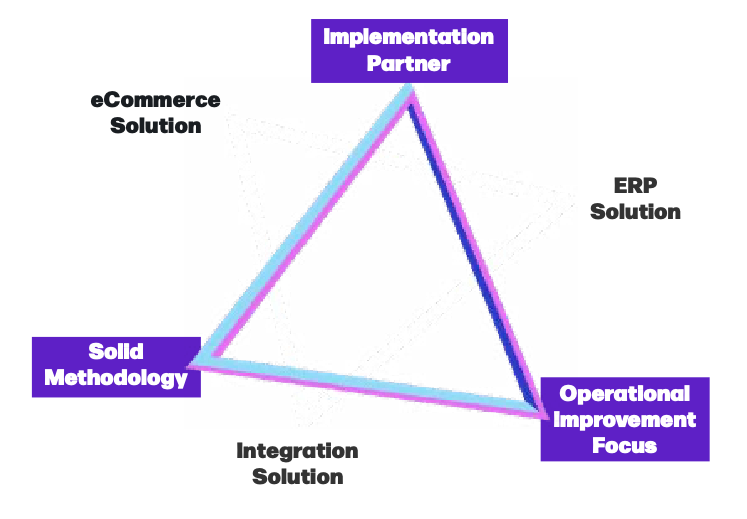Introduction
If the last couple of years has taught technology operational improvement specialists anything regarding the retail sector, it’s that a retailer’s need for an efficient, reliable and scalable eCommerce technology infrastructure has never been greater. The last two years have demonstrated the requirement for retailers to either up their existing eCommerce game or offer an eCommerce channel for the first time. The global retail sector will never be the same again.
According to Best Buy CEO, Corie Barry, as part of her remarks at CES 2021:
“There isn’t a world where people revert back to their 2019 behaviours, and part of that is just a comfort level.”
Trajectory client, La Bota Roja, a mid-sized 80 year old retailer, understands this fundamental shift better than anyone. Having never operated online before, La Bota Roja’s story of how they swiftly set up an eCommerce technology infrastructure, including an eCommerce storefront supported by ERP inventory management, demonstrates that eCommerce ecosystems are accessible to even mid-sized brands, if they choose the right technology solutions, the right implementation partner and follow the right implementation methodology.
This Insight will cover the following topics:
- What the current eCommerce revolution is about.
- What are current key eCommerce trends.
- What are the key success factors for companies considering embarking on an eCommerce technology infrastructure upgrade journey.
- How La Bota Roja successfully navigated their eCommerce transformation.

eCommerce Revolution
It comes as no surprise that one of the big impacts on retail in recent years has been the shift to online shopping. As evidenced by recent data from Shopify, one of the world’s largest online storefront solutions, Shopify’s previous Cyber Monday sales records were crushed in 2021 when worldwide sales on the Shopify platform totaled $6.3 billion, over double their 2019 Cyber Monday total sales value, and 23% higher than their 2020 Cyber Monday total sales value.
Consumer behaviour has changed forever. Consumers have become used to having all available options at their fingertips, plus suggestions for what they may be interested in based on their search patterns, with the added bonus of delivery to their homes. Consumers have become more fickle, wanting to find exactly what they want, as easily as possible, at the best price possible, and getting what they want fast.
What does this mean for retailers? This means that, at a minimum, retailers have to provide an eCommerce storefront for customers, the more intuitive and efficient the better. The retailers who excel, will be those who are able to create an engaging and consistent customer experience, from first touchpoint to purchase, both online and in-stores. What will it take to achieve this goal? The implementation of a scalable eCommerce technology ecosystem, consisting of an online storefront coupled with a robust back-end ERP solution. Shopify has acknowledged this reality with its creation of the Shopify Global ERP Program, that allows best-in-class ERPs to integrate with the Shopify App store in order to consolidate the sales, financial and inventory data to allow for a streamlined customer experience.
eConsumer Trends & Challenges
Some key consumer trends that must be addressed in this new eCommerce era include:
- Efficient Purchase Process – According to Google research, consumers are looking to meet their needs in the most efficient way possible, whether that means shopping exclusively online or researching online before heading to the store.
- Easy Search for Best Deals – According to Google research, consumers seek easy navigation, suggestions and reviews and better deals. Consumers consider themselves “deal finders”. 59% of US consumers say they prefer to shop online to get the best deal possible, which is also the number one thing that people say they enjoy about shopping.
- More Targeted Offerings – According to Gartner Research, by the end of 2025, all global multi-channel fashion retailers will use AI and automation to create more targeted assortments, reducing item choices by up to 30%.
The trends above present challenges for retailers. According to a December 2021 Neilson Report entitled, “Navigate the top challenges facing CPG and retail advertisers in 2022”, top challenges for retailers in 2022 include:
- Growth & Budgeting – Retailers are going to have to find ways to optimize their sales funnel, encouraging their existing customer base to buy again and find new customers through engaging multi-channel advertising material.
- Measurement & Transparency – It’s a proven fact that reliable data improves ROI. Having an eCommerce technology infrastructure in place that provides visibility into key sales, financial and operational data, and that facilitates the ability to effectively leverage that intelligence to improve operational capacity and efficiency, will in turn improve ROI.
Targeting – Sales growth potential will be dictated by an organization’s ability to effectively hone their messaging to their target audience(s), this new age of marketing communications is not one-size fits all. The more engaging and relevant the messaging is to a target customer, delivered at the right time with the right price point, can shorten the purchase cycle time and increase sales.
Given the increasingly competitive and complex retail landscape, what can retailers do to put themselves in the best strategic position to succeed?
- Remain Agile and Proactive
- Maximize Reach and Improve Messaging
- Optimize Marketing Efforts
A scalable eCommerce technology infrastructure is required to achieve the strategic imperatives outlined above. It is achieved through a combination of the selection of the right ecosystem elements i.e. technology solutions and the right implementation partner with the right implementation methodology. Read on to learn about what each of those looks like.

The Right Solutions – eCommerce Technology Ecosystem Elements
An effective eCommerce technology ecosystem is optimized only when the right solutions are combined to build an integrated environment, in which marketing and sales data is combined with finance and operational data to provide a holistic view of operations. In our experience at Trajectory, an ideal ecosystem for mid-market organizations who operate an eCommerce channel consists of a Shopify or NetSuite SuiteCommerce (depending on specific needs) solution integrated with Oracle NetSuite ERP.
Shopify Vs. NetSuite SuiteCommerce
Shopify is the eCommerce platform used by millions of online retailers worldwide, second in size to Amazon. Ten main reason why Shopify is such a popular platform, as outlined in The Rive Agency blog, “Why Businesses Choose Shopify as their eCommerce Store” include:
- Easy Management – of omni-channel sales
- Scalability – the platform can grow with your business, while not disrupting day-to-day operations
- Franchise Friendly – allows for enterprise level support and international expansion
- App Integrations – integrates with CRM and ERP softwares to provide a holistic view of operations
- Payment Options – has over 100 payment gateways integrated with the solution
- Sell Anywhere – can promote products and sell on multiple platforms including: Facebook, Instagram, Amazon
- Marketing Tools – includes built-in tools for audience targeting
- Store Insights – includes Advanced eCommerce analytics, to allow for monitoring and refinement of e-mail and SMS campaigns
- Support – platform provides 24/7 support including discussion forums at the Shopify Community
- SEO-Friendly – basic SEO functionality including on-page structure and optimization are built-in to the platform
In a lot of instances Shopify is a great choice, but if NetSuite is your ERP and your needs are more operations-centric, NetSuiteSuiteCommerce eStore may make more sense. The main benefits of a NetSuite SuiteCommerce solution include:
- Real-time Data Visibility/Reporting – Since the SuiteCommerce solution related data is part of the NetSuite database, inventory levels reflected on the web site are always accurate and financial and operational reporting always includes up-to-date information (does not rely on syncing of data with a third party system).
- Quick (within 30 days) & Easy Set-up – SuiteCommerce has many pre-built storefront templates to choose from that can be implemented quickly.
- No Integration Expenses/Maintenance – Not having integrations means no related integration expenses or maintenance.
Trajectory regularly assesses which solution best suits client needs and plans and executes the set-up so that the solution works well within the overall technology ecosystem.
eCommerce Solution Integration with NetSuite
NetSuite is a best-in-class, cloud based ERP solution used worldwide. The top reasons to choose NetSuite ERP, including 360 degree view of data, low IT management overhead, efficiency, scalability and solution flexibility are outlined in more detail here.
A key success factor for a highly efficient technology ecosystem depends on how smoothly the ERP and eCommerce systems are integrated. For this important function, Trajectory’s go to integration tool of choice is typically Boomi due to its quality, reliability and ease-of-use. In particular, Boomi benefits include:
- Agile Integration – Boomi is a leading cloud integration and workflow automation solution. It enables agile integration (faster and more efficient than developing custom code yourself).
- Easy Customization – Boomi has drag-and-drop data integration, customizable end-to-end workflows, and pre-built tools.
- Real-time Data Synchronization – Boomi’s unified platform allows customers to sync data in real-time. It also resolves quarantine issues and enriches data via a data hub.
Through Trajectory’s extensive use of the Boomi tool for dozens of integration projects over the last 15 years, the Trajectory team identified that some clients do not need the full breadth of Boomi functionality. We identified a gap in the market for a simplified integration option that would address the need to integrate basic customer and transactional data. Hence the concept of Trajectory’s integration product, Initus, was born. Initus offers the following benefits:
- Provides Only the Business Critical Functionality – Supports the integration of order, customer, and item related fields, to support streamlined sharing of business critical information between systems.
- Reasonable Price – Given that it’s a slimmed down middleware, you are only paying for the functionality that you need, and the reasonable rate card reflects this.
- Dependable Middleware Platform – Designed and built by experienced Trajectory software engineers in AWS, this platform is well-architected and maintained by the Trajectory Managed Services team, so that it is always running optimally.
Depending on the specific integration needs, will dictate whether Boomi or Initus is the right tool for the job. The Trajectory team is experienced at providing advice on what tool would work best for clients.
Key integration project success factors include:
- The Right Project Team – Including source and target system experts and integration solution experts from the beginning of the planning process.
- The Right Integration Tool – Typically Boomi or Initus.
- Thorough Integration Architecture Planning – Completing full requirements gathering prior to architecting the integration is critical. Considering factors such as integration timing, volume constraints, connection method, execution order, business rules identification, data field mapping, error reporting and management at the outset, will make for a smooth implementation.
- Detailed Testing Plan – Ensure that all business scenarios have been tested during the testing process.
Once the right solution elements are identified, the next step is to identify the right Technology Partner to transform the implementation from theory to reality.

The Right Technology Implementation Partner
When undertaking the creation of a technology ecosystem, beyond system expertise, you need a partner who has holistic business experience, who takes the time to understand a business before designing a technology solution for it, and who builds a solid execution and training plan.
Here’s what to look for when making the implementation partner selection decision:
Business Driven Mindset with Accredited Consultants – Look for a team of experienced and qualified business operations experts (with MBAs, CPAs, BComms) who happen to also have technical knowledge. Doing so ensures that the ultimate technology solution will be business needs driven rather than solution driven (i.e. trying to fit the business into the solution rather than vice versa). Having said that, being open to keeping as close to standard system processes where possible is always recommended in order to minimize customizations and related maintenance.
Dedicated Team of Consultants – Ensure you are assigned a dedicated cross-functional team consisting of consultants, software engineers/developers and project management professionals in order to have knowledge consistency throughout the project duration and between the different project work streams.
Seasoned Project Manager (PM) Involvement – Ensure a PM is part of the project team so that project metrics i.e. timelines, resourcing and budget are carefully tracked.
Business-Centric Methodology – Ensure that the execution methodology focuses on the business first rather than the solution, including detailed business requirements gathering sessions/best practice discussions. Then once the solution is configured ensure that there are rigorous testing and training plans to ensure the solution meets business needs and that the solution is successfully adopted by end-users.
Boutique Firm: Right-sized Team – Ideally find a partner who has several years of experience as well as deep bench-strength (over 20 employees), so that you benefit from a team with a wide breadth of knowledge and have team member redundancy throughout the project. Also, be sure to inquire if the implementation partner is a single company or whether it’s a group of independent contractors working together. There is a big difference between these two models in terms of smooth project delivery and knowledge sharing. The former model typically delivers a better solution more efficiently than the latter model.
Service Level Agreements – Ensure you are comfortable with service levels with respect to deliverables, communication and feedback timelines.
Quality Track Record – Speak to references for similar projects to the one you are undertaking, to confirm track record for work quality.
Reasonable IP Guidelines – Ensure the partner is willing to share documentation and code related to the project so that post project completion you receive the information needed to run the solution independently post Go-Live.
The Right Implementation Methodology
Once the technology ecosystem elements and implementation partner are identified, the key project element that facilitates successful project completion is a proven implementation methodology that includes the following steps:
Assemble an Effective Internal Project Team – Ensure to assemble the right team, including: Project Manager, Project Sponsor and Project Subject Matter Experts (SMEs) by functional area.
Create an Effective Change Management Plan – Effectively engaging key stakeholders in the planning and execution phases of the project and explaining the reasons for the project and what will be in it for them, will go a long way to facilitating a smooth implementation.
Implement an Effective Project Management Strategy – Following a Blueprint, Build, Balance and Optimize implementation structure will allow for a proactive and logical execution of the implementation to catch any issues early and ensure a smooth Go-Live.
Design and Execute an Effective Training Plan – The importance of a solid training plan can not be underestimated. Building the system is one thing, but having users embrace it is another, and the key to system adoption is a confident user group who have been well-trained. Also implementing a supportive escalation procedure for post Go-Live on-going support is also highly effective.
Engage in Business Process Mapping/Redesign – Implementing a new solution presents opportunities to rethink how things have always been done, and to embrace new ways of doing things. Our recommendation is to stay as close to native solution functionality as possible in order to minimize maintenance and issues in the future.
Data Migration Worked on Throughout Build Phase – A system is only as useful as the data it contains. Be sure to focus on data preparation and testing from the beginning of the build phase of the project. Practicing extracting data from source systems, massaging it into the NetSuite required formats, and loading it once or twice into the test environment before completing the Production loads just prior to Go-Live is our recommended practice, which prevents data related pitfalls and project delays.
Let’s explore how the right solutions, the right technology implementation partner and the right methodology all came together for La Bota Roja’s eCommerce technology ecosystem implementation project, working with Trajectory.

La Bota Roja – eCommerce Technology Ecosystem Implementation – Putting Theory into Practice
Like so many local and regional retailers around the world, La Bota Roja — founded in the 1940s — succeeded on the strength of its in-store customer experiences and had no eCommerce presence in March 2020. Then, after 80 years of operating one successful channel, La Bota Roja found itself among the countless businesses that suddenly needed to shift to eCommerce, as consumers worldwide avoided stores and flocked to online retailers.
Key challenges for La Bota Roja included:
- How to quickly implement a robust, scalable end-to-end eCommerce and inventory-management system to achieve a quick pivot and to set the foundation for omni-channel growth.
- How to extend La Bota Roja’s tradition of excellent customer experiences to its eCommerce store, by unifying data to show accurate stock availability and offering low-friction checkout options to drive conversions.
“La Bota Roja always values the trust and time of our customers, which is why we’re different and why customers of all generations remember the experience of having visited our stores.”
Ramiro Mendez
La Bota Roja General Manager
La Bota Roja’s successful eight-month journey from no eCommerce presence to a fully functioning omni-channel eCommerce platform with unified data and one-tap checkout, offers a model that other mid-sized retailers can follow. The keys to success were choosing the right technology solutions and an experienced implementation partner.
La Bota Roja – The Digital Transformation Backstory
Before working with Trajectory, each La Bota Roja department used its own legacy software solutions for daily tasks, including manual spreadsheets for inventory management and PDF creation for invoicing. This time-consuming approach, coupled with frequent on-premises system outages, undermined performance and raised costs.
La Bota Roja’s management team knew it was time to make the leap to a reliable, scalable cloud solution, to consolidate systems, centralize data, improve inventory management, and support the launch of eCommerce operations. It was an ambitious project, one that the team knew they needed to move forward on quickly when pandemic-related lockdowns pushed consumers online in the spring of 2020. The goals were to remain competitive while in-store traffic was down and to build a solid strategic omni-channel presence for years to come.
Seamless Omni- Channel Experiences now Drive Retail Success
Nearly 80% of consumers now “see the world as all digital, with no divide” between online and physical domains. So, while eCommerce is an essential retail channel, retail success now rests on the ability to create cohesive customer experiences online and in stores.
Providing those experiences requires a unified view of retail data for growth and budgeting, KPI tracking, and personalized customer interactions. Unified data is also fueling AI-driven, automated optimization of retail inventory assortments, a practice that “all global multi-channel fashion retailers” will adopt by the end of 2025. To meet the growing need for scalable eCommerce data integration, Shopify now partners with major ERP vendors including Microsoft Dynamics 365 Business Central, Oracle NetSuite, Infor, Acumatica, and Brightpearl. Shopify’s Global ERP Program gives retailers “a centralized system that connects their commerce platform to key business data like financials and inventory so they can optimize operations and processes.”
La Bota Roja’s management team knew they needed a solution that would not only achieve their eCommerce aspirations, but also allow them to stay agile and proactive, maximize their brand reach and messaging, and support continuous measurement and optimization. The team had an ambitious list of requirements for their transformation, including:
- Replacing an out-dated custom single-tenant server solution
- Optimizing inventory and shipping management
- Integrating third-party POS systems
- Managing complex tax requirements
Because La Bota Roja’s previous technology implementation partners had not met their expectations, and because the rapid global move to eCommerce had raised the stakes for successful digital transformation, the retailer proceeded cautiously in selecting the appropriate partner for this major and now urgent project.
The Right Technology Partner and Solutions: Finding the right partner and optimal technology solutions for their eCommerce ecosystem
La Bota Roja knew they needed more than technology expertise. They also needed consultants who would take a holistic approach and understand their unique business before planning a technology solution. In addition, they sought a technology implementation partner with a focus on value creation through strategic technology solution selection and with a properly certified, highly experienced team of consultants to navigate their complex requirements with ease.
Their search led them to Trajectory. The engagement began with a study of La Bota Roja and a full review of their business needs. Based on their findings, La Bota Roja’s Trajectory team designed a holistic technology ecosystem that addressed all of the company’s business process needs, end-to-end, including:
- NetSuite ERP: the best cloud-based ERP solution for giving middle-market companies a 360-degree view of business performance with a scalable modular structure and flexible pricing.
- Shopify eCommerce storefront: the industry leader for retailers seeking to synchronize store data with back-end systems to unify data for better inventory visibility, flexible shipping and payment options, easy change management, and customer portal creation.
- BSALE electronic invoicing solution
- Credit Card Payment Integration
- Shipping Integration

The Right Integration Tool: Initus – An Integration Solution Built for Mid-sized Businesses
Properly integrating NetSuite, Shopify, and BSALE — and integrating the system with the local tax authorities – was key to delivering a valuable solution for La Bota Roja. Trajectory’s experience since 2008 as a leading Integration consultancy allowed the team to develop a custom integration plan designed to optimize functionality while reducing time to value, using Trajectory’s proprietary Initus middleware for simple, streamlined, cost-effective integrations.
“Trajectory provides a strong business team that understands business operations, and designs sophisticated solutions with the ultimate objective to support clients’ exponential growth. We also provide a strong technical team, capable of executing and delivering the proposed solutions. Finally, we are solution agnostic, so we focus on providing the best possible solutions using the most appropriate platforms based on clients’ unique needs.”
Alex Olano
Trajectory
President and Managing Partner
The Right Implementation Methodology: Trajectory’s Implementation Approach in Action
With La Bota Roja’s business needs and goals understood, a technology ecosystem mapped out, and an integration platform selected, Trajectory began the implementation. Time was of the essence because of the drop in foot traffic to brick-and-mortar stores and the consumer shift to eCommerce, but the new solution also needed to create a long-lasting, agile foundation for omni-channel growth.
Within eight months, La Bota Roja implemented a Custom Order Management module with specific customized processes, an Inventory Management Module including more than 95,000 SKUs, a Warehousing module, their new Shopify online storefront, and integration of the ecosystem.
Trajectory also helped La Bota Roja’s team navigate the change management journey, with thorough training so the retail team could embrace the new solution and the new business processes that came with it.
The Results: A Streamlined eCommerce Experience, Complete Digital Transformation
La Bota Roja now manages more than 100,000 transactions involving more than 20,000 SKUs monthly. The retailer also enjoys:
- Holistic business data visibility with a centralized view of all retail data for all departments and channels in one searchable system.
- Centralized real-time inventory management across all physical locations and the online store.
- Efficient warehouse management through La Bota Roja’s centralized system with automated shipping integration to streamline logistics.
- Frictionless online customer experience with Shopify’s best-in-class eCommerce features, including one-tap checkout.
- Continuous, automated data collection with all Shopify data flowing into NetSuite for efficient invoicing and financial management.
- Ongoing system support and optimization guidance through Trajectory Managed Services.
“Leveraging their netsuite-shopify technology ecosystem, La Bota Roja offers best-of-breed shopping experiences to its customers, including mobile and one-tap checkout. The solution also provides real time product information, pricing and product availability, thanks to NetSuite’s warehouse management capabilities. Best of all, the entire solution is based on NetSuite ERP, so there is a single source of data for the sales, operations, accounting and executive teams to use to optimize the business.”
Vlad Olano
Trajectory
VP of Operations
Ramiro Mendez, La Bota Roja General Manager, said that working with Trajectory was revolutionary for the company, and not simply because the new system gives his team greater visibility into their data, which has allowed them to improve their forecasting and warehouse management capabilities. The new solution also eliminated historic operational system issues that had drained resources. Now, Mendez noted, his team can focus on running and growing the business rather than troubleshooting.
“Trajectory has a transparent approach that was tailored to our specific needs. They reviewed our problems thoroughly and set the roadmap and budget for how to address them. Having worked with them, we can trust that they deliver on time, with a global professional attitude that adds value to our processes.”
Ramiro Mendez
La Bota Roja
General Manager
To Wrap-up
Consumer and market trends are clear – providing consumers intuitive, streamlined and high quality online and offline experiences made possible by strong back-end metrics and the ability to track and respond to purchasing trends provided by a best-in-class eCommerce technology infrastructure – have become strategic imperatives in the competitive eCommerce space. Retailers must create a consistent experience between their various channels, with consolidated real-time data and analytics, and with reliable distribution channels to meet the high demands of fickle customers. Even historic brands that are new to the eCommerce space can get “online” quickly if they make the right technology and implementation partner choices.

Vlad Olano
VP Operations, Managing Partner
Vlad, with over 15 years of technical and solution delivery experience, oversees overall project delivery at Trajectory. He attributes Trajectory’s success to the team’s genuine commitment to clients, and their ability to consistently deliver solutions that drive measurable business value



